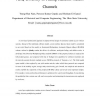211 search results - page 14 / 43 » Dynamic Rate Allocation in Fading Multiple-access Channels |
CORR
2006
Springer
13 years 7 months ago
2006
Springer
A cross-layer optimization approach is adopted for the design of symmetric random access wireless systems. Instead of the traditional collision model, a more realistic physical la...
CORR
2010
Springer
13 years 8 months ago
2010
Springer
In this paper, we provide a new achievable ergodic secrecy rate region for the multiple access wiretap channel in fading. Our achievable scheme is based on repeating each symbol at...
EJWCN
2010
13 years 2 months ago
2010
We present a general game-theoretical framework for the resource allocation problem in the downlink scenario of distributed wireless small-cell networks, where multiple access poi...
CORR
2007
Springer
13 years 7 months ago
2007
Springer
Abstract— A power optimal scheduling algorithm that guarantees desired throughput and bounded delay to each user is developed for fading multi-access multi-band channels that can...
CORR
2007
Springer
13 years 7 months ago
2007
Springer
— Convexity/concavity properties of symbol error rates (SER) of the maximum likelihood detector operating in the AWGN channel (non-fading and fading) are studied. Generic conditi...

